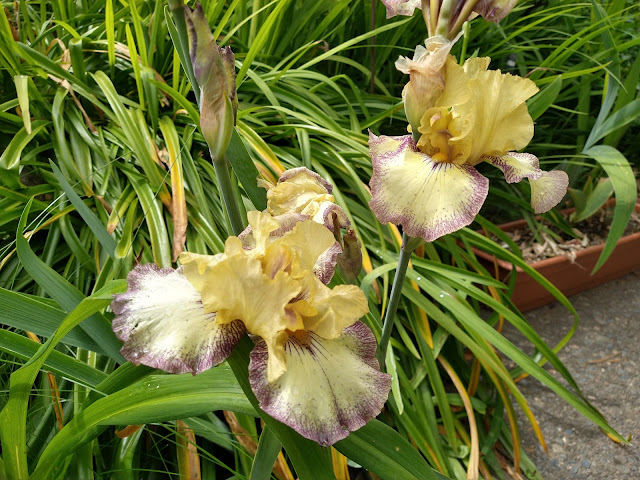
See hundreds of irises in bloom; take some home, too

|
|
This beauty is a Tennessee Gentleman iris, purchased several years ago at the
Sacramento Iris Show. See many varieties at the show and sale this weekend.
(Photo: Debbie Arrington)
|
One of Sacramento’s favorite spring flowers gets its turn in the spotlight this weekend when the Sacramento Iris Society hosts its annual show and sale.
Shepard Garden and Arts Center in McKinley Park will be overflowing with bearded irises and other species in their colorful glory. With the theme “National Parks,” the iris show will be open to the public from 1 to 5 p.m. Saturday, April 23, and 10 a.m. to 3 p.m. Sunday, April 24.
This will be a judged show with many different varieties and kinds of irises vying for awards. It’s a great opportunity to learn about the many different color combinations and how to better identify varieties.
Take some home, too! The club will offer potted irises for sale with plants ready to transplant now.
Bearded iris, the most common perennial iris, is a water-wise wonder that thrives in Sacramento. After showy spring blooms, bearded irises need little summer irrigation – just once a week or twice a month. The plant dies back in August before sprouting new growth in late fall or winter.
Originally hybridized in Germany, bearded irises (also known as flags) now include more than 60,000 named cultivars and come in every color from pure white to black with countless shades in between. The most common colors are blues and purples, closest to the iris family’s native hues.
Admission and parking are free. Shepard Center is located at 3330 McKinley Blvd., Sacramento.
Details and directions: www.sgaac.org or https://sacramentoirissocietydotcom.wordpress.com/ .
Comments
0 comments have been posted.Sacramento Digs Gardening to your inbox.
Sites We Like
Garden Checklist for week of April 21
This week there’s plenty to keep gardeners busy. With no rain in the immediate forecast, remember to irrigate any new transplants.
* Weed, weed, weed! Get them before they flower and go to seed.
* April is the last chance to plant citrus trees such as dwarf orange, lemon and kumquat. These trees also look good in landscaping and provide fresh fruit in winter.
* Smell orange blossoms? Feed citrus trees with a low dose of balanced fertilizer (such as 10-10-10) during bloom to help set fruit. Keep an eye out for ants.
* Apply slow-release fertilizer to the lawn.
* Thoroughly clean debris from the bottom of outdoor ponds or fountains.
* Spring brings a flush of rapid growth, and that means your garden is really hungry. Feed shrubs and trees with a slow-release fertilizer. Or mulch with a 1-inch layer of compost.
* Azaleas and camellias looking a little yellow? If leaves are turning yellow between the veins, give them a boost with chelated iron.
* Trim dead flowers but not leaves from spring-flowering bulbs such as daffodils and tulips. Those leaves gather energy to create next year's flowers. Also, give the bulbs a fertilizer boost after bloom.
* Pinch chrysanthemums back to 12 inches for fall flowers. Cut old stems to the ground.
* Mulch around plants to conserve moisture and control weeds.
* From seed, plant beans, beets, cantaloupes, carrots, corn, cucumbers, melons, radishes and squash.
* Plant onion sets.
* In the flower garden, plant seeds for asters, cosmos, celosia, marigolds, salvia, sunflowers and zinnias.
* Transplant petunias, zinnias, geraniums and other summer bloomers.
* Plant perennials and dahlia tubers for summer bloom.
* Mid to late April is about the last chance to plant summer bulbs, such as gladiolus and tuberous begonias.
* Transplant lettuce seedlings. Choose varieties that mature quickly such as loose leaf.